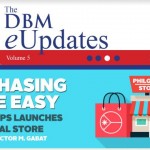The key considerations for any SMB business owner before investing in a new phone system or new unified collaboration solution are whether this investment is improving profitability, increasing productivity or reducing operational cost. Asset investment needs to deliver a positive return on investment. It should enables your people to be more efficient and productive.
Below, you’ll find the TOP 5 Tips for choosing an IP PBX for a Small Medium Business.
#1 Easy to use real time communications
Studies according to “MobileSQUARED advertising report,” a mobile research firm, shows that 90% of messages are read within 3 minutes, this is clearly showing how time sensitive and real time communications have become critical to business today.
SMBs can benefit greatly from simple tools, like email plug-in application that allows users to access contacts without opening separate applications and be able click-to-call, click to IM, click to SMS directly from their email applications. This is a very effective way to increase productivity and to decrease cost, especially if integrating with 3rd party internet calls providers.
Conferencing is also becoming the cornerstone of the real time communication. You will want to check the sound quality of the speaker on the desk phone as well as the microphone to ensure that your conference calls are audible for you and your participants (wideband audio, noise cancellation….) This is very important when you have frequent and multiple daily business conference calls. This element is often overlooked as a key requierement for productivity increase.
In addition, surveys have shown that many SMB employees keep a paper directory document and use it everytime they want to call someone in their company. By the simple fact to integrate a directory in the telephone system and to provide a “call by name” feature, even with external alphabetical keyboard on the deskphone, it will provide great improvement on daily productivity.
#2 Investment protection
You may want to consider how requirements might change over time, and make sure you get a system that will scale with your future company size and needs. This could requiere some significant analysis. But, it it important to pre-plan your decision based on future expansions, and based on selecting a vendor that has been in the market for many years, which has shown that it will be able to support and maintain your system in the long term.
Reduce operational cost by planning to reverse the cost curve between operating and managing complex systems. Look in to replacing with a system targeted for SMB which offers high business value, low complexity and attractive pricing. It is impressive to see how cost effective and capable SMB telephony systems have become – you could pay much less today in operating cost but get a strong productivity increase. Make sure you are selecting an easy to use and easy to maintain telephony system, and this will assure a much lower operational cost on the long term.
Many SMB are also considering CAPEX and OPEX as cost of operating a network. Don’t put too much significance on initial capiral expenditure and installation cost, look at the long term on-going cost, and do an analysis of the true real cost of ownership. One of the significant factor that should be looked at is the “gain or loss” of revenue because of the telephony network. A ROI is measured by increased transactions, increased productivity, increase customer satisfaction and then by cost saving.
#3 Mobility – BYOD – remote workers
In early 2014, internet usage from mobile devices exceeded PC/laptop usage.
The challenge for a SMB is to balance the risk of opening the door to mobility while gaining the advantages brought by BYOD. Many businesses are coming up with alternate solutions, for example, limiting functions and restricting access to company information.
Other capabilities providing users with Web applications can keep users in touch with their company anywhere using any compatible desktop web browser (from a smartphone, a tablet, a desktop computer or a laptop on Mac/Windows, etc…) whenever they have internet access, simplifying the maintenance and support. This permits users to access call logs anywhere, and to forward their extensions to any phones whether a mobile or home phone, etc.
Applications such as NFC (Near Field Communications) have been gaining traction with easy on-site mobility that delivers benefit from session shift between desk phone and their NFC-enabled smartphone.
More and more companies consider how mobile users and teleworkers can work from anywhere, anytime, whether from home, or from a Starbucks, on the road. Providing the right solution could be complex, between a highly secure but expensive solution, or a simple solution with higher security risk. The analysis of the different solutions should be reviewed carefully and selected based on individual companies’ needs.
#4 Network Assessment
SMBs have a need to implement productivity-enhancing IT services with reduced costs. With that need, they face the complexity between network security, mobility, quality of services and class of services for local applications or cloud applications running on their data network.
A study done in 2015 “Network barometer 2015” looked at large installed based of mid to large customers showed surprising results:
– 60% of network devices have at least one security vulnerability
– 74% of wireless access points are still older models (802.11g and older) that don’t support a sound mobility and security strategy.
– 53% of network devices are aging or obsolete (and it is growing year over year)
These points above show it is critical to review the status of your network infrastructure.
If you are a SMB owner looking at implementing VoIP, BYOD or real time application, it is critical to review the current status of your data network.
SMBs have to find the right balance between security risk, cost and advantages to open the network. Upgrading your network to the latest technology and latest software version is a critical element to make sure VoIP, UC, and BYOD investments run smoothly based on your infrastructure.
#5: Technology alone won’t solve your collaboration problems
Based on a study in March 2015 from “Harvard Business review by Mark Mortensen,” every week a vendor introduces a new gadget, system or services that promises to make us communicate and collaborate better. However, the reality is that most results are actually not providing much improvement in collaboration and productivity increase.
It’s not what technology you’ve got, but how you use it! The important point is to align knowledge management systems (or any system for that matter) with how people actually work. While we often think of the future of collaboration resting on the shoulders of technology, that is only part of the story. Sure, technology provides opportunities, but it’s important to view technology and social systems as partners. The promise of tomorrow’s collaboration requires actively considering, designing, and fine-tuning both.
Discuss with our consultants
Going through this exercise can take some time, but this is one of the most important business infrastructure decisions you’ll make, so it’s worth taking the time to pre-plan so you make the right business value decision. Alcatel-Lucent Enterprise is the leading European provider of communication solutions. We will be pleased if you would like to engage with our communication advisers.
Source: http://blog-enterprise.alcatel-lucent.com/article/top-5-tips-choosing-ip-pbx-your-small-business
read more






